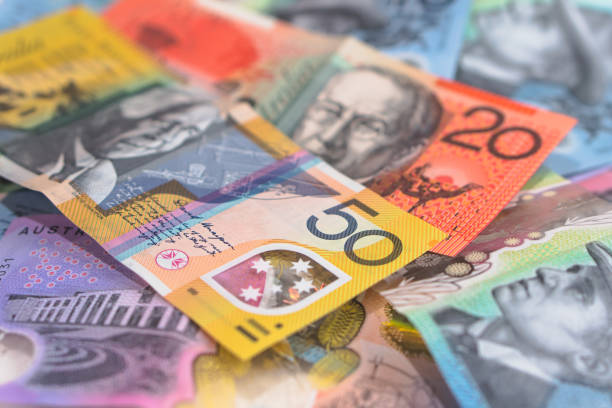AUD/USD slides back below 0.6500 on US-China trade war fears, notable USD strength
- Gold Price Hits New High: Has Bitcoin Fully Declined?
- Gold jumps above $4,440 as geopolitical flare, Fed cut bets mount
- U.S. November CPI: How Will Inflation Fluctuations Transmit to US Stocks? Tariffs Are the Key!
- Breaking: Gold rises to record high above $4,500 on safe-haven flows
- US Q3 GDP Released, Will US Stocks See a "Santa Claus Rally"?【The week ahead】
- December Santa Claus Rally: New highs in sight for US and European stocks?

AUD/USD attracts some sellers on Monday amid a goodish pickup in the USD demand.
Bets for slower Fed rate cuts lift the US bond yields higher and lend support to the USD.
US-China trade war concerns further contribute to driving flows away from the Aussie.
The AUD/USD pair starts a new week/month on a weaker note and slides back below the 0.6500 psychological mark during the Asian session, snapping a three-day winning streak. Moreover, the fundamental backdrop supports prospects for the resumption of the recent downtrend witnessed over the past two months or so.
Worries about the second wave of the US-China trade war after US President-elect Donald Trump takes office in January drive some haven flows towards the US Dollar (USD) and undermine the China-proxy Australian Dollar (AUD). In fact, Trump has pledged big tariffs against America’s three biggest trading partners – Mexico, Canada and China. Furthermore, Trump threatened a 100% tariff on the so-called 'BRICS' nations – Brazil, Russia, India, China, and South Africa – if they replace the USD with another currency for international transactions.
Meanwhile, the growing market conviction that Trump's tariff plans could push consumer prices higher and restrict the Federal Reserve (Fed) from easing its monetary policy further triggers a fresh leg up in the US Treasury bond yields. Apart from this, persistent geopolitical risks stemming from the protracted Russia-Ukraine war assist the safe-haven USD in staging a recovery from a nearly three-week low touched on Friday. This overshadows the Reserve Bank of Australia's (RBA) hawkish stance and does little to lend support to the Aussie.
Data released over the weekend showed that China’s official Manufacturing Purchasing Managers' Index (PMI) edged up to 50.3 in November from 50.2, while the NBS Non-Manufacturing PMI eased to 50.0 during the reported month from 50.2 in October. Adding to this, China's Caixin Manufacturing PMI jumped to 51.5 in November from 50.3. Moreover, investors remain hopeful that the government will introduce more stimulus to bolster domestic demand. This, however, fails to impress bulls or provide any respite to the AUD/USD pair.
The aforementioned fundamental backdrop suggests that the path of least resistance for spot prices is to the downside, though traders might refrain from placing aggressive bets ahead of key US macro data scheduled at the beginning of a new week. This week's busy US economic docket kicks off with the release of the ISM Manufacturing PMI, which might influence the USD and allow traders to grab short-term opportunities. The focus, however, remains glued to the closely watched US jobs data, or the Nonfarm Payrolls (NFP) report on Friday.
Australian Dollar FAQs
One of the most significant factors for the Australian Dollar (AUD) is the level of interest rates set by the Reserve Bank of Australia (RBA). Because Australia is a resource-rich country another key driver is the price of its biggest export, Iron Ore. The health of the Chinese economy, its largest trading partner, is a factor, as well as inflation in Australia, its growth rate and Trade Balance. Market sentiment – whether investors are taking on more risky assets (risk-on) or seeking safe-havens (risk-off) – is also a factor, with risk-on positive for AUD.
The Reserve Bank of Australia (RBA) influences the Australian Dollar (AUD) by setting the level of interest rates that Australian banks can lend to each other. This influences the level of interest rates in the economy as a whole. The main goal of the RBA is to maintain a stable inflation rate of 2-3% by adjusting interest rates up or down. Relatively high interest rates compared to other major central banks support the AUD, and the opposite for relatively low. The RBA can also use quantitative easing and tightening to influence credit conditions, with the former AUD-negative and the latter AUD-positive.
China is Australia’s largest trading partner so the health of the Chinese economy is a major influence on the value of the Australian Dollar (AUD). When the Chinese economy is doing well it purchases more raw materials, goods and services from Australia, lifting demand for the AUD, and pushing up its value. The opposite is the case when the Chinese economy is not growing as fast as expected. Positive or negative surprises in Chinese growth data, therefore, often have a direct impact on the Australian Dollar and its pairs.
Iron Ore is Australia’s largest export, accounting for $118 billion a year according to data from 2021, with China as its primary destination. The price of Iron Ore, therefore, can be a driver of the Australian Dollar. Generally, if the price of Iron Ore rises, AUD also goes up, as aggregate demand for the currency increases. The opposite is the case if the price of Iron Ore falls. Higher Iron Ore prices also tend to result in a greater likelihood of a positive Trade Balance for Australia, which is also positive of the AUD.
The Trade Balance, which is the difference between what a country earns from its exports versus what it pays for its imports, is another factor that can influence the value of the Australian Dollar. If Australia produces highly sought after exports, then its currency will gain in value purely from the surplus demand created from foreign buyers seeking to purchase its exports versus what it spends to purchase imports. Therefore, a positive net Trade Balance strengthens the AUD, with the opposite effect if the Trade Balance is negative.
Read more
* The content presented above, whether from a third party or not, is considered as general advice only. This article should not be construed as containing investment advice, investment recommendations, an offer of or solicitation for any transactions in financial instruments.

